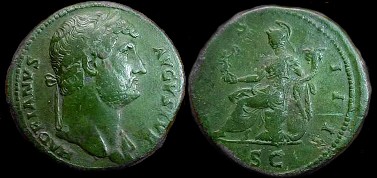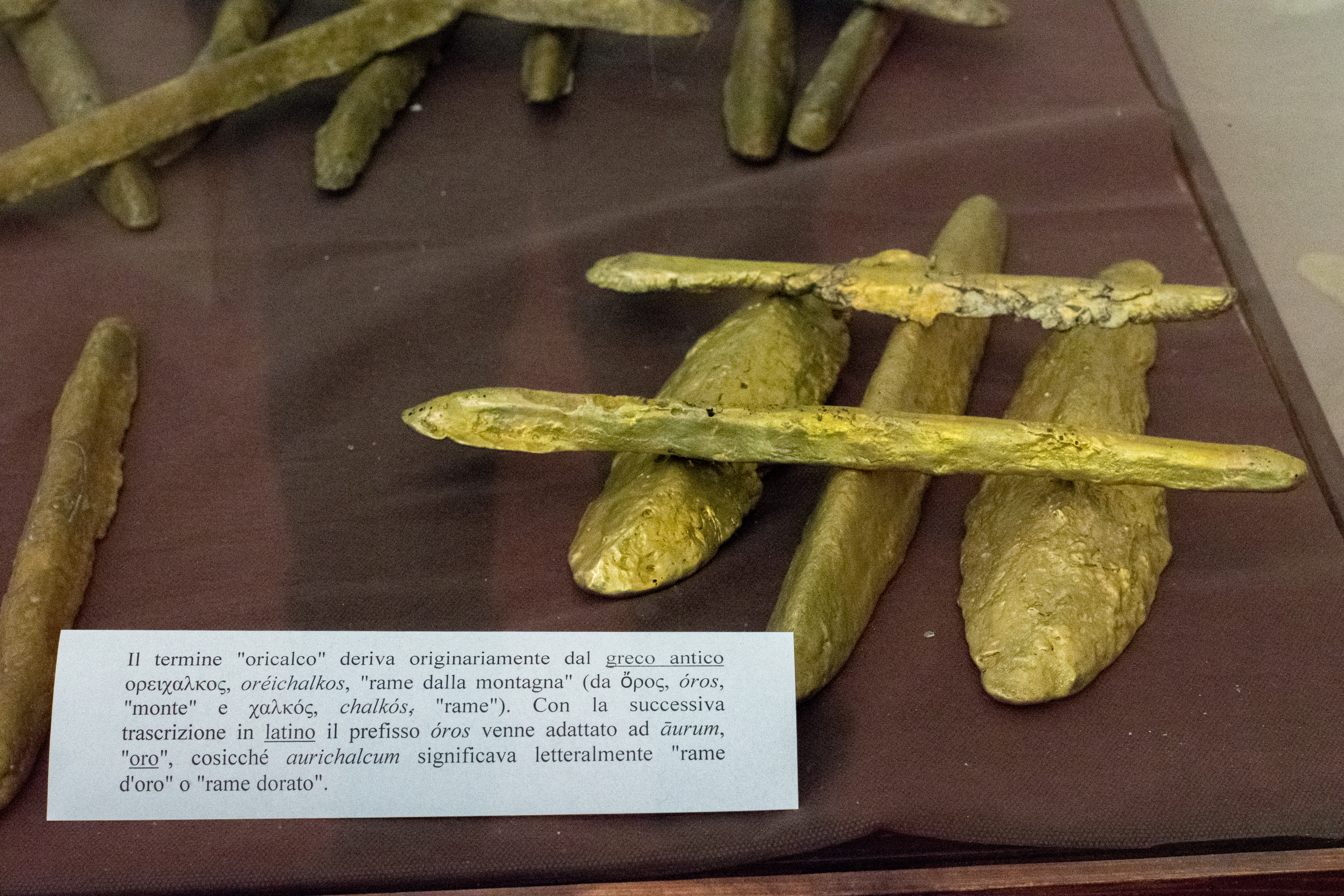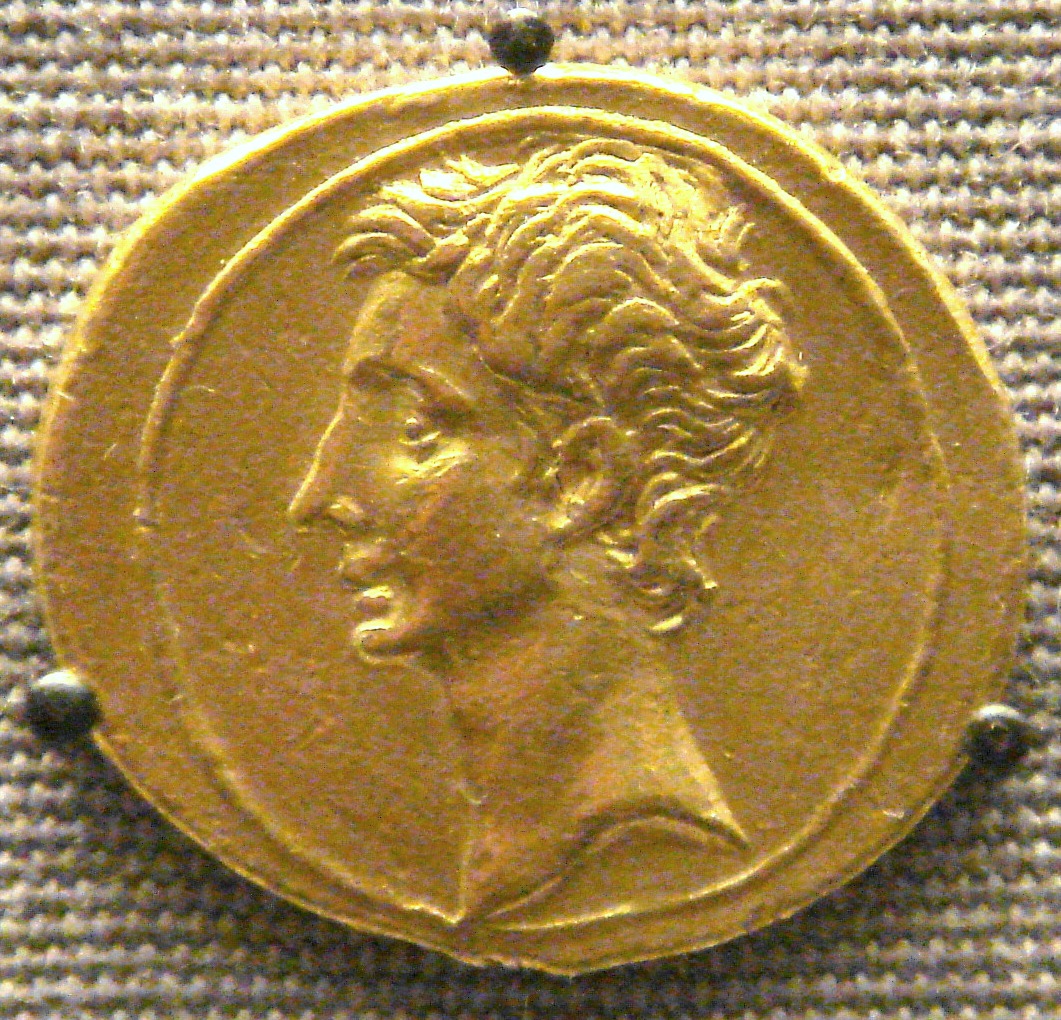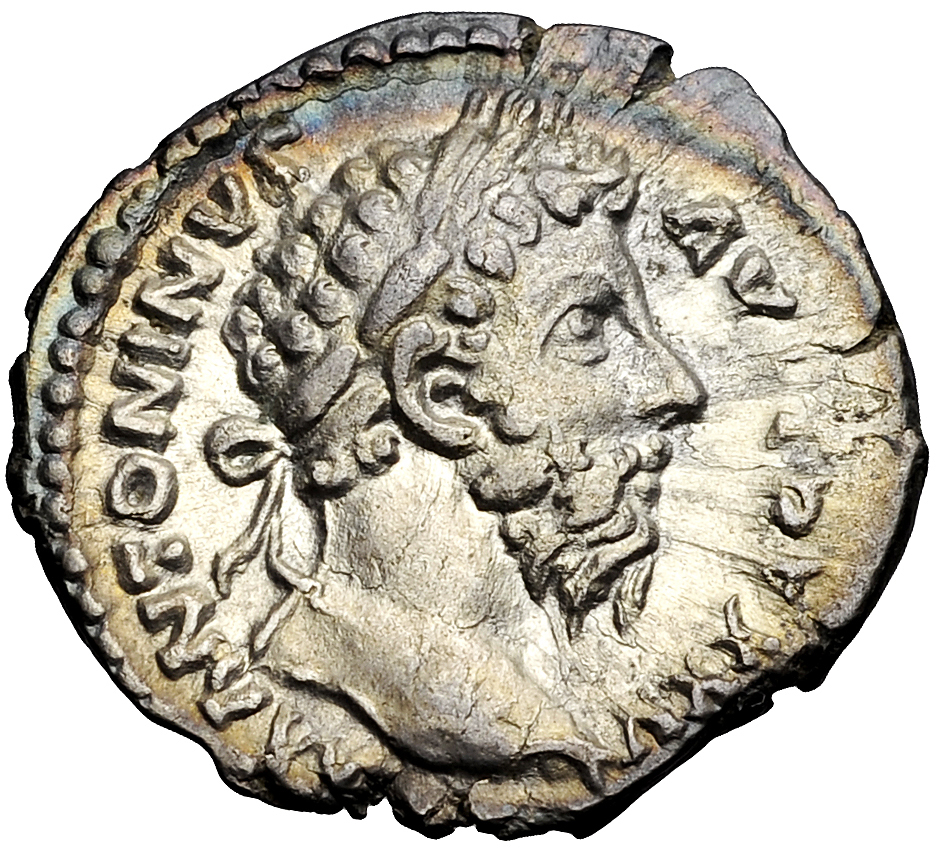|
Sestertius
The ''sestertius'' (: ''sestertii'') or sesterce (: sesterces) was an Ancient Rome, ancient Roman Roman currency, coin. During the Roman Republic it was a small, silver coin issued only on rare occasions. During the Roman Empire it was a large brass coin. The name ''sestertius'' means "two and one half", referring to its nominal value of two and a half ''as (Roman coin), asses'' (a bronze Roman coin, singular ''as''), a value that was useful for commerce because it was one quarter of a denarius, a coin worth ten ''asses''. The name is derived from ''semis'', "half" and ''tertius'', "third", in which "third" refers to the third ''as'': the sestertius was worth two full ''asses'' and half of a third. English-language sources routinely use the original Latin form ''sestertius'', plural ''sestertii''; but older literature frequently uses ''sesterce'', plural ''sesterces'', ''terce'' being the English equivalent of ''tertius''. A modern shorthand for values in sestertii is IIS (Un ... [...More Info...] [...Related Items...] OR: [Wikipedia] [Google] [Baidu] |
Double Sestertius
The double ''sestertius'' was a large Roman coin made of orichalcum ("gold-brass") first issued by Emperor Trajan Decius in AD 249–251, as a response to the inflationary pressures of the time which had devalued the buying power of the conventional ''sestertius''. In reality the new coin was little bigger than the traditional ''sestertius'', which by then was being manufactured at a lower weight and smaller size than it had originally been, and was not a success. Although commonly described as a "double" ''sestertius'', it was probably worth only one ''sestertius'' and a half. The new coin fell out of use but was revived by the rebel emperor Postumus (259–268), who ruled a breakaway empire consisting of Britain, Gaul and parts of Germany, and was keen to associate his regime with a reformed coinage system. Postumus issued his own version of the double ''sestertius'', often taking very worn old ''sestertii'' and using these to overstrike his own portrait and legends on, probabl ... [...More Info...] [...Related Items...] OR: [Wikipedia] [Google] [Baidu] |
Dupondius
The ''dupondius'' (Latin ''two-pounder'') was a brass coin used during the Roman Republic and Roman Empire valued at 2 '' asses'' (4/5 of a ''sestertius'' or 1/5 of a ''denarius'' during the Republic and 1/2 of a ''sestertius'' or 1/8 of a ''denarius'' during the time of Augustus). The ''dupondius'' was introduced during the Roman Republic as a large bronze cast coin, although even at introduction it weighed less than 2 Roman pounds (''librae''). The initial coins featured the bust of Roma on the obverse and a six-spoked wheel on the reverse. A loaf of bread or a ''sextarius'' ( L) of wine cost roughly one ''dupondius'' at the height of the Roman Empire, though due to the debasement of the ''denarius'' over the following century, the ''dupondius'' was discarded. With the coinage reform of Augustus in about 23 BC, the ''sestertius'' and ''dupondius'' were produced in a type of brass called orichalcum by the Romans and numismatists, while lower denominations were produced out ... [...More Info...] [...Related Items...] OR: [Wikipedia] [Google] [Baidu] |
Orichalcum
Orichalcum (or aurichalcum) or orichalc is a metal mentioned in several ancient writings, including the story of Atlantis in the ''Critias'' of Plato. Within the dialogue, Critias (460–403 BC) says that orichalcum had been considered second only to gold in value and had been found and mined in many parts of Atlantis in ancient times, but that by Critias's own time, orichalcum was known only by name. Orichalcum may have been a noble metal such as platinum, as it was supposed to be mined, but has been identified as pure copper or certain alloys of bronze, and especially brass alloys in the case of antique Roman coins, the latter being of "similar appearance to modern brass" according to scientific research. Overview The name is derived from the Greek , ' (from , ', mountain and , ', copper), literally meaning "mountain copper". The Romans transliterated "orichalcum" as "aurichalcum", which was thought to mean literally "gold copper". It is known from the writings of Cicer ... [...More Info...] [...Related Items...] OR: [Wikipedia] [Google] [Baidu] |
Denarius
The ''denarius'' (; : ''dēnāriī'', ) was the standard Ancient Rome, Roman silver coin from its introduction in the Second Punic War to the reign of Gordian III (AD 238–244), when it was gradually replaced by the ''antoninianus''. It continued to be minted in very small quantities, likely for ceremonial purposes, until and through the Tetrarchy (293–313). The word ''dēnārius'' is derived from the Latin ''dēnī'' "containing ten", as its value was originally of 10 ''As (Roman coin), assēs''.Its value was increased to 16 assēs in the middle of the 2nd century BC. The word for "money" descends from it in Italian (''denaro''), Slovene (''denar''), Portuguese (''dinheiro''), and Spanish (''dinero''). Its name also survives in the dinar currency. Its symbol is represented in Unicode as 𐆖 (U+10196), a numeral monogram that appeared on the obverse in the Republican period, denoting the 10 ''asses'' ("X") to 1 ''denarius'' ("I") conversion rate. However it can also be re ... [...More Info...] [...Related Items...] OR: [Wikipedia] [Google] [Baidu] |
As (Roman Coin)
The ' (: '), occasionally ''assarius'' (: ''assarii''; ), was a bronze, and later copper, coin used during the Roman Republic and Roman Empire. Republican era coinage The Romans replaced the usage of Greek coins, first by bronze ingots, then by disks known as the '' aes rude''. The system thus named ''as'' was introduced in ca. 280 BC as a large cast bronze coin during the Roman Republic. The following fractions of the were also produced: the (), (), (), (), (), (), (, also a common weight unit), and (), as well as multiples of the ''as'', the (2), (2), and (3). After the ''as'' had been issued as a cast coin for about seventy years, and its weight had been reduced in several stages, a ''as'' was introduced (meaning that it weighed one-sixth of a pound). At about the same time a silver coin, the ''denarius'', was also introduced. Earlier Roman silver coins had been struck on the Greek weight standards that facilitated their use in southern Italy and across t ... [...More Info...] [...Related Items...] OR: [Wikipedia] [Google] [Baidu] |
Aureus
The ''aureus'' ( ''aurei'', 'golden') was the main gold coin of ancient Rome from the 1st century BC to the early 4th century AD, when it was replaced by the ''solidus (coin), solidus''. This type of coin was sporadically issued during the Roman Republic, Republic and standardized during the Roman Empire, Empire, originally valued at 25 silver ''denarius, denarii'' and 100 Sestertius, ''sestertii''. It was about the same size as the ''denarius'', but heavier than the ''denarius'' since gold is denser than silver. During the Republic The production of proper Roman currency, Roman coins began in the 3rd century BC and was limited to the minting of bronze ''As (Roman coin), asses''; the gold brought back from spoils and war indemnities was stored in the public treasury (''Aerarium''). According to the needs of the state finances, the gold in the reserve was sold for minted silver, at a ratio of 1 to 12. The Second Punic War (218–201), due to its considerable financing needs, mad ... [...More Info...] [...Related Items...] OR: [Wikipedia] [Google] [Baidu] |
Vespasian
Vespasian (; ; 17 November AD 9 – 23 June 79) was Roman emperor from 69 to 79. The last emperor to reign in the Year of the Four Emperors, he founded the Flavian dynasty, which ruled the Empire for 27 years. His fiscal reforms and consolidation of the empire brought political stability and a vast building program. Vespasian was the first emperor from an Equestrian (Roman), equestrian family who rose only later in his lifetime into the Roman Senate, senatorial rank as the first of his family to do so. He rose to prominence through military achievement: he served as legatus, legate of Legio II Augusta during the Roman invasion of Britain in 43, and later led the suppression of the First Jewish–Roman War, Jewish rebellion of 66–70. While he was engaged in the campaign in Judaea (Roman province), Judaea, Emperor Nero died by suicide in June 68, plunging Rome into a year of civil war known as the Year of the Four Emperors. After Galba and Otho perished in quick succession, V ... [...More Info...] [...Related Items...] OR: [Wikipedia] [Google] [Baidu] |
Antoninianus
The ''antoninianus'' or pre-reform radiate was a coin A coin is a small object, usually round and flat, used primarily as a medium of exchange or legal tender. They are standardized in weight, and produced in large quantities at a mint in order to facilitate trade. They are most often issued by ... used during the Roman Empire thought to have been valued at 2 ''Denarius, denarii''. It was initially silver, but was slowly debasement, debased to bronze with a minimal silver content. The coin was introduced by Caracalla in early 215 AD. It was silver, similar to the ''denarius'', except that it was slightly larger and featured the Roman emperor, emperor wearing a radiate crown, indicating it was a double denomination. ''Antoniniani'' depicting women (usually the Roman emperor, emperor's wife) featured the bust resting upon a crescent moon. Even at its introduction, the silver content of the ''antoninianus'' was only equal to 1.5 ''denarii''. This created infla ... [...More Info...] [...Related Items...] OR: [Wikipedia] [Google] [Baidu] |
Roman Empire
The Roman Empire ruled the Mediterranean and much of Europe, Western Asia and North Africa. The Roman people, Romans conquered most of this during the Roman Republic, Republic, and it was ruled by emperors following Octavian's assumption of effective sole rule in 27 BC. The Western Roman Empire, western empire collapsed in 476 AD, but the Byzantine Empire, eastern empire lasted until the fall of Constantinople in 1453. By 100 BC, the city of Rome had expanded its rule from the Italian peninsula to most of the Mediterranean Sea, Mediterranean and beyond. However, it was severely destabilised by List of Roman civil wars and revolts, civil wars and political conflicts, which culminated in the Wars of Augustus, victory of Octavian over Mark Antony and Cleopatra at the Battle of Actium in 31 BC, and the subsequent conquest of the Ptolemaic Kingdom in Egypt. In 27 BC, the Roman Senate granted Octavian overarching military power () and the new title of ''Augustus (title), Augustus'' ... [...More Info...] [...Related Items...] OR: [Wikipedia] [Google] [Baidu] |
Roman Currency
Roman currency for most of Roman history consisted of gold, silver, bronze, orichalcum#Numismatics, orichalcum and copper coinage. From its introduction during the Roman Republic, Republic, in the third century BC, through Roman Empire, Imperial times, Roman currency saw many changes in form, denomination, and composition. A feature was the inflationary debasement and replacement of coins over the centuries. Notable examples of this followed the reforms of Diocletian. This trend continued with Byzantine currency. Due to the economic power and longevity of the Roman state, Roman currency was widely used throughout western Eurasia and northern Africa from classical times into the Middle Ages. It served as a model for the currencies of the List of Muslim states and dynasties, Muslim caliphates and the European states during the Middle Ages and the Modern Era. Roman currency names survive today in many countries via the Carolingian monetary system, such as the dinar (from the ''denari ... [...More Info...] [...Related Items...] OR: [Wikipedia] [Google] [Baidu] |
Debasement
A debasement of coinage is the practice of lowering the intrinsic value of coins, especially when used in connection with commodity money, such as gold or silver coins, while continuing to circulate it at face value. A coin is said to be debased if the quantity of gold, silver, copper or nickel in the coin is reduced. Examples Roman Empire In Roman currency, the value of the denarius was gradually decreased over time as the Ancient Rome, Roman government altered both the size and the silver content of the coin. Originally, the silver used was nearly pure, weighing about 4.5 grams. From time to time, this was reduced. During the Julio-Claudian dynasty, the denarius contained approximately 4 grams of silver, and then was reduced to 3.8 grams under Nero. The denarius continued to shrink in size and purity, until by the second half of the third century, it was only about 2% silver, and was replaced by the Argenteus. Ottoman Empire Weight of akçe in grams of silver and ind ... [...More Info...] [...Related Items...] OR: [Wikipedia] [Google] [Baidu] |







